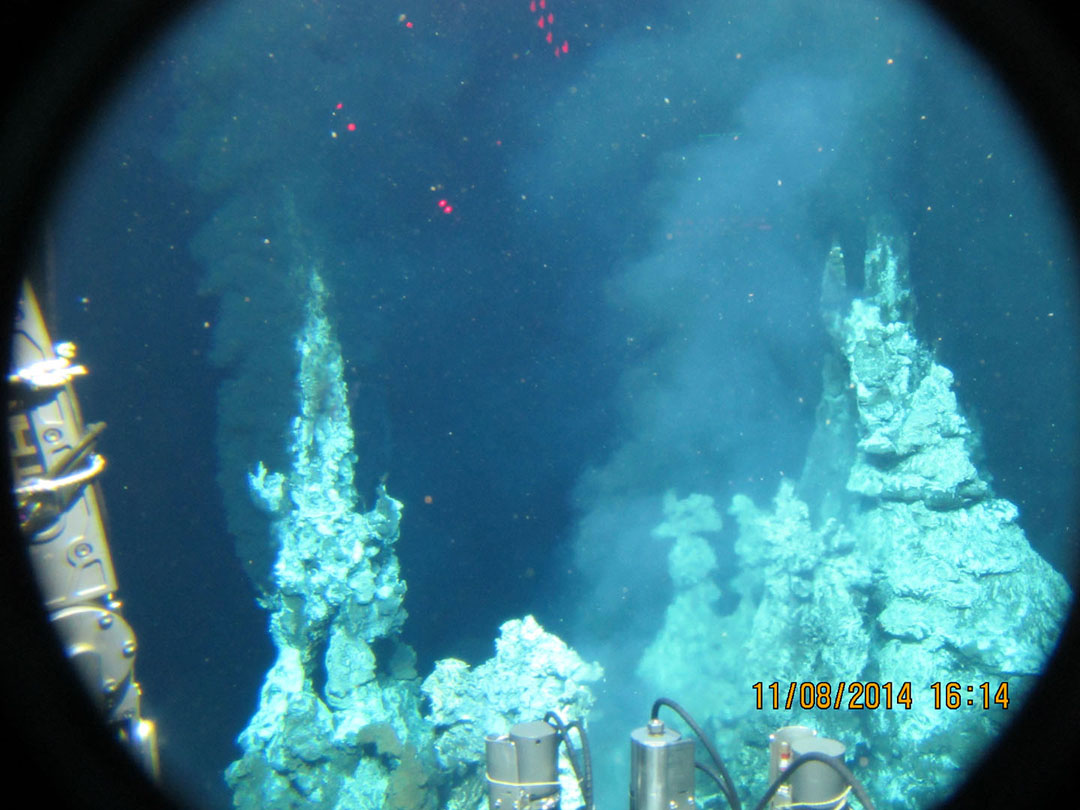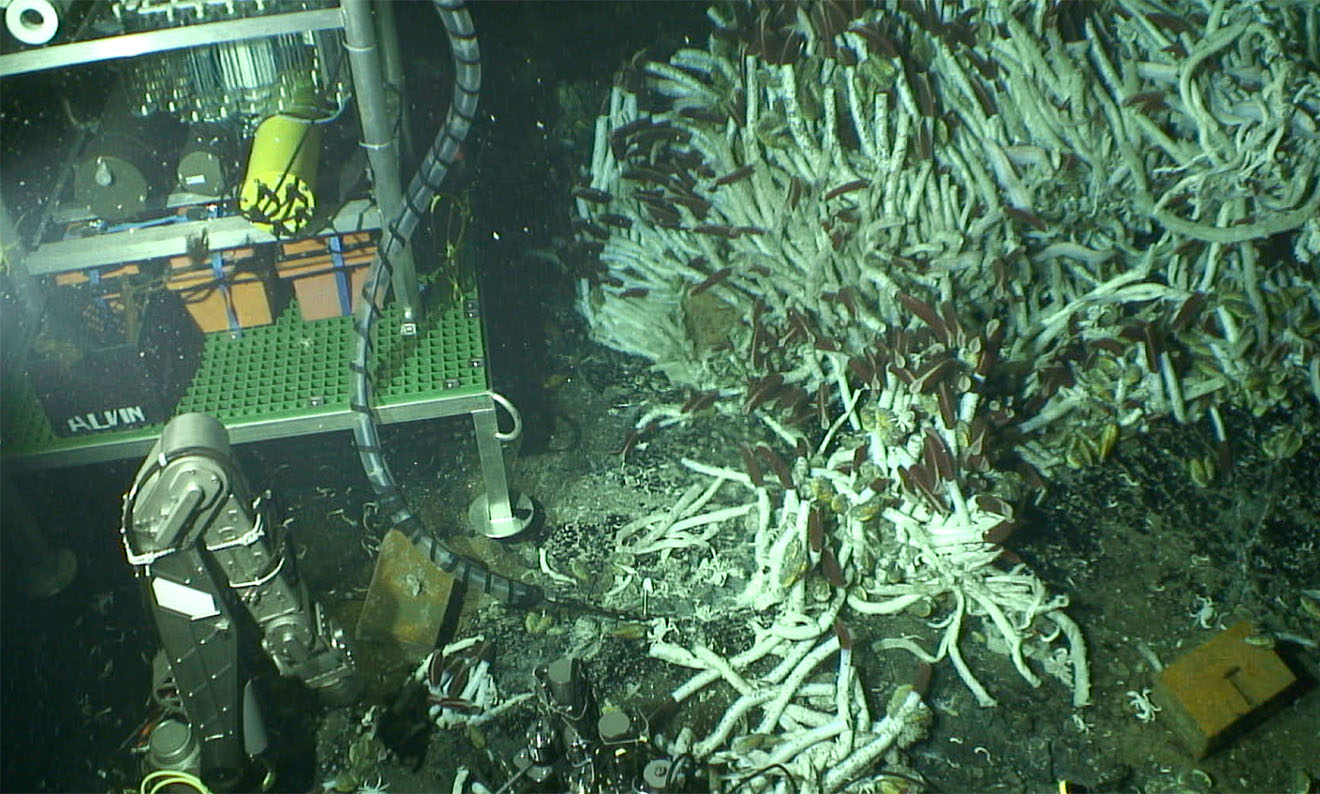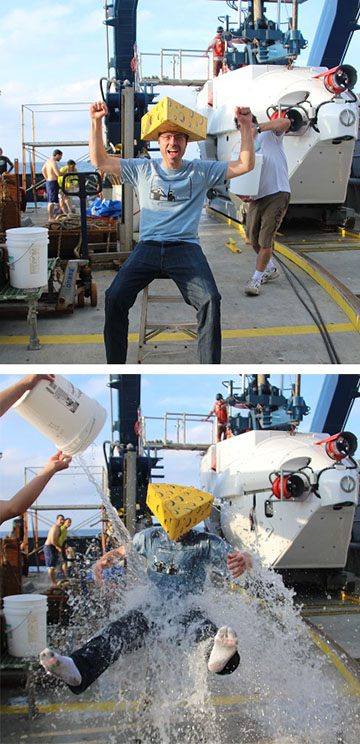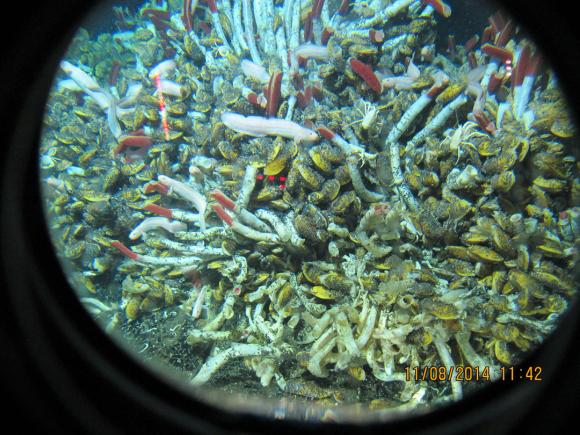PROVIDENCE, R.I. [Brown University] — The research vessel Atlantis sailed due south for two days to reach the spot where lines drawn south from Denver and west from Costa Rica would cross. The 260-foot ship stopped at that point on a sunny Nov. 5 morning. The next day, amid squalls of rain, the ship sent precious cargo overboard: a robotic instrument that after years of planning, could now be deployed to examine the hydrothermal vents of the Pacific Ocean floor.
Jeremy Rich, assistant professor of ecology and evolutionary biology at Brown, described that Vent-Submersible Incubation Device (Vent-SID) as something of a multishelved lunar lander. It took nine hours to descend 2,500 meters to the bottom — possibly, Rich said, swaying its way down like a falling leaf despite its payload of bulky batteries, electronics and other gadgetry.
The device was designed to gather and incubate samples of the microbes that inhabit the fluids of hydrothermal vents. But before Rich and his colleagues could get the valuable data they had sought so long, he and two others would have to go in after it, find it, and move it into position more than a mile beneath the churning sea.

White and black pillars a couple of stories high, “black smokers” are mineral formations composed of the sulfides and iron that precipitate from the boiling water welling up from the vents. Photo: Jeremy Rich, ©Woods Hole Oceanographic Institution
For the sake of science
Rich and Brown postdoctoral scholar Nuria Fernandez-Gonzalez are on board the Nov. 2-26 expedition, led by Woods Hole Oceanographic Institution scientist Stefan Sievert, to study the metabolism of the vent microbes, which process carbon dioxide, oxygen, and nitrogen. Scientists from around the United States, and China, Germany, and Japan are running several projects, but Rich and Fernandez-Gonzalez are particularly interested to learn how much the microbes rely on denitrification — converting nitrogen as they encounter it into the nitrogen gas that makes up 80 percent of the atmosphere.
“If denitrification turns out to support a significant fraction of microbial activity, it would provide an important step forward in understanding how microbes at vents live,” he said. “As [the] microbes are at the base of the food chain at hydrothermal vents, our study will provide fundamental knowledge about how these amazing ecosystems function.”
Characterized by their extreme heat, the ecosystems of hydrothermal vents resemble the conditions life likely endured when it first emerged billions of years ago.

The submersible research platform went over the side first. Researchers pursued it in a submersible named Alvin and positioned it in a field of hydrothermal vents where it could gather samples and collect data.
Photo courtesy of chief scientist Stefan Sievert, Woods Hole Oceanographic Institution; funding agency: National Science Foundation; ©Woods Hole Oceanographic Institution
A dream-like descent
On Saturday Nov. 8, after a technical delay, Rich, pilot Phil Forte, and microbiologist and principal investigator Craig Taylor, dove in the submersible craft Alvin to find the Vent-SID, grab it with Alvin’s arm, and deploy it at the right location in a field of vents.
“The dive to the bottom was not at all scary, but was exhilarating, magical, and full of life,” said Rich, who had never dived like this before. “Even before we got to the vent fields and turned on the lights while sinking, we could see many little creatures, some small jellyfish floating through the water.”
The bottom proved to be a wondrous alien world, rife with towering geological sculpture and the bountiful beauty of deep sea marine biology.
“We set down on basalt rock from a recent lava flow,” Rich said. “Some of the flow was cracked and heaved up, showing many layers upon layers of lava. Alvin easily picked up the SID with one of its arms and we transited to the deployment site.
“As we went, we soon entered the hydrothermal vent field, with large spires and ridges of basalt rising above, like looking up the sides of a small canyon,” he said. “The spires and cracks in the ridges were bursting with life, with lush patches of riftia tubeworms, abundant long, white zoarcid fish, and large shrimp swimming toward the lights of Alvin. It was a bit like being in a dream-like aquarium.”
They deployed the Vent-SID and moved on to gather a sample of exotic structures called “black smokers.” These white and black pillars, a couple of stories high, are mineral formations composed of the sulfides and iron that precipitate from the boiling water welling up from the vents.

Shipmates prepared an NFL-style celebration for Rich, a native of Green Bay Packers territory, after his maiden voyage to the sea floor in the submersible Alvin, rear. Image: Juliana Leonard
Back aboard: a welcome and some work
At the surface, colleagues and crew welcomed the diving rookie with a ritual befitting a winning football coach. They seated the Wisconsin native on the Atlantis deck, decked him out in a “cheesehead” hat favored by Green Bay Packers fans, and doused him with large buckets of ice water.
Enduring that moment of chilly silliness was not Rich’s only sacrifice for the mission. To ensure that Alvin’s emergency oxygen mask would fit snugly over his mouth if needed (it rarely is), Rich agreed to shave a beard he had worn for 18 years.
The next day, when a new trio aboard the Alvin brought the Vent-SID to the surface, the researchers checked the device’s condition and harvested any samples. This had been the device’s maiden voyage. Part of the mission was simply to ensure it would work.
It did, but not completely. It carried some samples, but some containers were empty and incubation had been interrupted. But the device had survived its round trip intact, so the team set to work identifying software bugs at the source of its initial miscues.
There is still plenty of time on the voyage to try again. Dedicated scientists and crew members are hard to keep down.
When Rich first boarded, he and his colleagues worked feverishly into the early morning to prepare the Vent-SID for its first descent but had to delay lowering it into the water.
“It was part of what I find rewarding about being a scientist,” he said, “pushing myself to the limit to accomplish an experiment, and it is inspiring to be around other scientists doing the same.”
When their Alvin dive was delayed as well, Rich didn’t fret much. “It is the nature of the business,” he said — the business of studying nature, wherever it leads.
The Woods Hole Oceanographic Institution’s “Dark Life” blog keeps up with the expedition, which is funded by the National Science Foundation.

